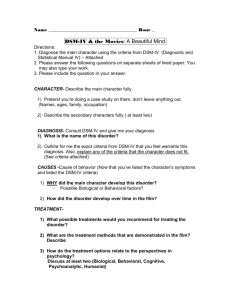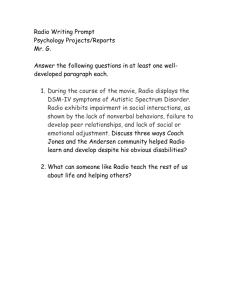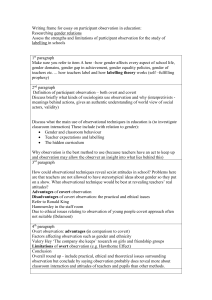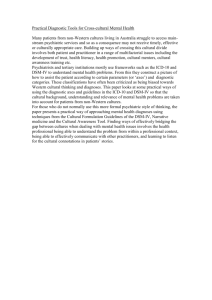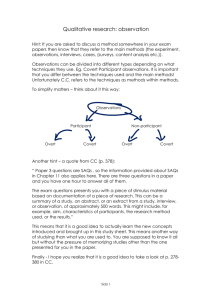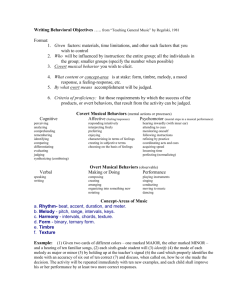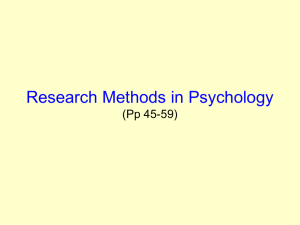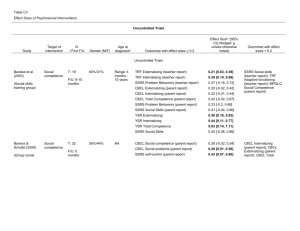Conduct Disorder
advertisement
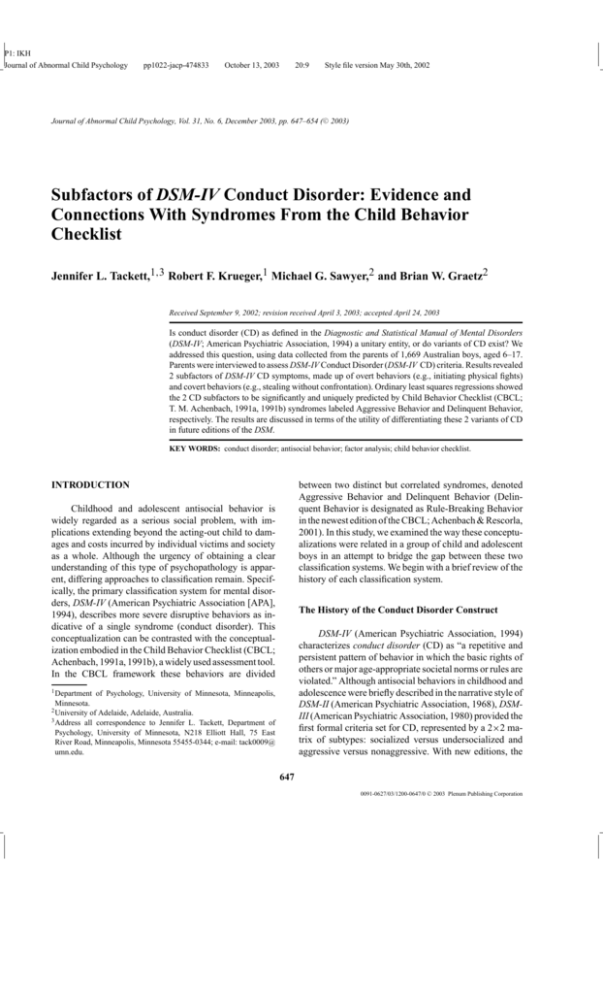
P1: IKH Journal of Abnormal Child Psychology pp1022-jacp-474833 October 13, 2003 20:9 Style file version May 30th, 2002 C 2003) Journal of Abnormal Child Psychology, Vol. 31, No. 6, December 2003, pp. 647–654 (° Subfactors of DSM-IV Conduct Disorder: Evidence and Connections With Syndromes From the Child Behavior Checklist Jennifer L. Tackett,1,3 Robert F. Krueger,1 Michael G. Sawyer,2 and Brian W. Graetz2 Received September 9, 2002; revision received April 3, 2003; accepted April 24, 2003 Is conduct disorder (CD) as defined in the Diagnostic and Statistical Manual of Mental Disorders (DSM-IV; American Psychiatric Association, 1994) a unitary entity, or do variants of CD exist? We addressed this question, using data collected from the parents of 1,669 Australian boys, aged 6–17. Parents were interviewed to assess DSM-IV Conduct Disorder (DSM-IV CD) criteria. Results revealed 2 subfactors of DSM-IV CD symptoms, made up of overt behaviors (e.g., initiating physical fights) and covert behaviors (e.g., stealing without confrontation). Ordinary least squares regressions showed the 2 CD subfactors to be significantly and uniquely predicted by Child Behavior Checklist (CBCL; T. M. Achenbach, 1991a, 1991b) syndromes labeled Aggressive Behavior and Delinquent Behavior, respectively. The results are discussed in terms of the utility of differentiating these 2 variants of CD in future editions of the DSM. KEY WORDS: conduct disorder; antisocial behavior; factor analysis; child behavior checklist. INTRODUCTION between two distinct but correlated syndromes, denoted Aggressive Behavior and Delinquent Behavior (Delinquent Behavior is designated as Rule-Breaking Behavior in the newest edition of the CBCL; Achenbach & Rescorla, 2001). In this study, we examined the way these conceptualizations were related in a group of child and adolescent boys in an attempt to bridge the gap between these two classification systems. We begin with a brief review of the history of each classification system. Childhood and adolescent antisocial behavior is widely regarded as a serious social problem, with implications extending beyond the acting-out child to damages and costs incurred by individual victims and society as a whole. Although the urgency of obtaining a clear understanding of this type of psychopathology is apparent, differing approaches to classification remain. Specifically, the primary classification system for mental disorders, DSM-IV (American Psychiatric Association [APA], 1994), describes more severe disruptive behaviors as indicative of a single syndrome (conduct disorder). This conceptualization can be contrasted with the conceptualization embodied in the Child Behavior Checklist (CBCL; Achenbach, 1991a, 1991b), a widely used assessment tool. In the CBCL framework these behaviors are divided The History of the Conduct Disorder Construct DSM-IV (American Psychiatric Association, 1994) characterizes conduct disorder (CD) as “a repetitive and persistent pattern of behavior in which the basic rights of others or major age-appropriate societal norms or rules are violated.” Although antisocial behaviors in childhood and adolescence were briefly described in the narrative style of DSM-II (American Psychiatric Association, 1968), DSMIII (American Psychiatric Association, 1980) provided the first formal criteria set for CD, represented by a 2×2 matrix of subtypes: socialized versus undersocialized and aggressive versus nonaggressive. With new editions, the 1 Department of Psychology, University of Minnesota, Minneapolis, Minnesota. 2 University of Adelaide, Adelaide, Australia. 3 Address all correspondence to Jennifer L. Tackett, Department of Psychology, University of Minnesota, N218 Elliott Hall, 75 East River Road, Minneapolis, Minnesota 55455-0344; e-mail: tack0009@ umn.edu. 647 C 2003 Plenum Publishing Corporation 0091-0627/03/1200-0647/0 ° P1: IKH Journal of Abnormal Child Psychology pp1022-jacp-474833 October 13, 2003 20:9 648 criteria have been modified with simplified subtyping in DSM-III-R (American Psychiatric Association, 1987; a socialized type, a solitary–aggressive type, and undifferentiated type with mixed features) to the current DSMIV definition, which uses no subtypes based on symptom profile. According to DSM-IV, any 3 of 15 symptoms representing various antisocial behaviors constitute a CD diagnosis. So, although CD is conceptualized as a unitary construct, a diagnosis can encompass quite different types of symptoms. For example, one child may be diagnosed with CD on the basis of only aggressive symptoms; bullying, initiating physical fights, and using a weapon would constitute a CD diagnosis. A second child may also be diagnosed with CD but exhibit only nonaggressive symptoms. For example, staying out late at night without permission, stealing without confrontation, and repeatedly skipping school would also constitute a CD diagnosis. Moreover, a third child with a CD diagnosis might exhibit some mixture of aggressive and nonaggressive behaviors. In this research, we attempt to parse this potential heterogeneity within the CD criteria by exploring the possibility of coherent subconstructs within the broad CD construct. Factor-Analytic Research on DSM-Derived Disruptive Behavior Constructs Factor analysis is one statistical technique that can search for patterns in covariation among a group of symptoms, in order to identify possible underlying factors within the symptoms that may help explain these patterns of covariation. For example, previous factor-analytic research using DSM-III and DSM-III-R (American Psychiatric Association, 1980, 1987) symptoms of childhood disruptive behavior has identified a distinction between overt and covert behaviors. Most of these studies have focused on providing support for distinguishing CD from oppositional defiant disorder (ODD), which is characterized in the DSM-IV (American Psychiatric Association, 1994) by a pattern of defiant, hostile, and irritable behavior. A study by Frick et al. (1991) involved data based on DSM-III and DSM-III-R criteria sets. These investigators found that when symptoms of CD and ODD were included together in a factor analysis, the ODD and aggressive CD symptoms loaded on one dimension whereas covert or nonaggressive CD symptoms loaded on a second. These findings were consistent with earlier reviews of factoranalytic studies in childhood disruptive behavior (Loeber & Schmaling, 1985; Quay, 1986). Frick et al. (1993) subsequently conducted a metaanalysis of findings from 60 factor analyses reported in 44 published studies that examined DSM III and III-R symptoms of ODD and CD, as well as substance use. Style file version May 30th, 2002 Tackett, Krueger, Sawyer, and Graetz Initial analyses revealed one bipolar dimension with all symptoms of ODD and the aggressive symptoms of CD on one pole (labeled overt) and the nonaggressive symptoms of CD and substance use symptoms on the opposite pole (labeled covert). However, when a second orthogonal dimension was extracted, an additional bipolar axis made up of destructive versus nondestructive behaviors more thoroughly explained the covariation among the symptoms. When the symptoms were graphed into the four quadrants defined by the overt/covert and destructive/nondestructive axes, almost all of the ODD symptoms lay in the overt-nondestructive quadrant, whereas the CD symptoms were more evenly divided among the other three quadrants. This meta-analysis supported the CD/ODD distinction and additionally emphasized the need to examine variation in the symptoms of CD, particularly within the new DSM-IV criteria. In one-factor analysis focused on DSM criteria, Rey and Morris-Yates (1993) factor-analyzed 22 CBCL items bearing a face valid resemblance to the DSM-III-R symptoms for CD and ODD. The study was done using an adolescent clinical sample of 528 girls and boys who met criteria for CD (N = 189), ODD (N = 75), or another diagnosis (N = 264). The results supported four factors, labeled aggression, delinquency, oppositionality, and escapism. Similar to the quadrants defined in the Frick et al. (1993) meta-nalysis, the oppositional CBCL items loaded on one factor, with overt antisocial aggression, delinquent activities, and efforts to escape from demands placed on the participant (comparable to the Frick et al. covert/nondestructive dimension) loading on the other three. In a more recent study, Hartman et al. (2001) used confirmatory factor analyses to explore the assumption that DSM-IV childhood disorders represent underlying discrete constructs. Their results showed secondary loadings for several CD symptoms on a factor defined primarily by ODD symptoms. Although this work was concerned with the covariance among symptoms reflecting multiple disorders (rather than the possibility of specific CD subfactors), these results challenge the presumed unidimensionality of CD by showing evidence of significant heterogeneity within the DSM-IV symptoms. In sum, these studies provide evidence of a distinction between ODD and CD, as well as evidence of significant heterogeneity within CD symptoms. Although factor labels have varied somewhat among studies, the labels overt (referring to aggressive behavior) and covert (referring to nonaggressive behavior) have commonly been applied. Although the descriptive accuracy of these labels may not be ideal, overt and covert will be applied to subfactors of DSM CD criteria throughout this paper for P1: IKH Journal of Abnormal Child Psychology pp1022-jacp-474833 October 13, 2003 20:9 Style file version May 30th, 2002 Subfactors of Conduct Disorder two reasons: (1) to maintain consistency with past literature on this topic and (2) to distinguish references to the CBCL Aggressive Behavior (hereafter referred to as “Aggression”) and Delinquent Behavior (hereafter referred to as “Delinquency”) syndromes from references to the DSM CD subfactors. The distinction between overt and covert CD symptoms appears similar to the distinction between Agression and Delinquency, although relations between the two have not yet been assessed directly. In addition, subfactors within CD have not yet been explored using DSMIV criteria. If there are subfactors of the CD construct, further questions are as follows: How do these CD subfactors relate to the Aggressive and Delinquent CBCL syndromes? How do they relate to hypothesized developmental subtypes of antisocial behavior? We now turn to these topics. 649 lems. Second-order factor analyses uncovered two broad higher level factors, labeled Internalizing and Externalizing, that accounted for a significant portion of the covariation among the eight syndromes. The Externalizing dimension consists of two subsyndromes, labeled Aggressive and Delinquent. The item content of these two syndromes distinguishes the more overt acting-out behaviors from the more covert behaviors. This study represents an initial step toward bringing the languages of the CBCL and the DSM-IV together. Specifically, we asked the following questions: (1) Is CD better conceptualized as a unitary construct as in the DSMIV or as a variegated dimension with distinct facets? (2) If DSM-IV CD factors exist, how are they related to the domains of antisocial behavior assessed by the CBCL? METHOD Developmental and Empirically Based Perspectives Research Participants Paralleling the factor-analytic distinction between aggressive and nonaggressive child behavior problems, developmental theories have suggested that the distinction between aggressive and nonaggressive behaviors may have utility in distinguishing causes, underlying biological mechanisms, severity, and outcomes (Lahey, Waldman, & McBurnett, 1999; Loeber, 1982; Moffitt, 1993). For example, research has shown the aggressive/nonaggressive distinction to be strongly related to age of onset of antisocial behavior (Lahey et al., 1998; Moffitt, 1993). In addition, behavior genetic studies have revealed differences in the etiologies of aggressive and nonaggressive behavior related to the age of onset. Most research has converged on the finding that early-onset aggressive behavior is more highly heritable, whereas late-onset delinquency has a greater shared environmental component (e.g., DiLalla & Gottesman, 1989; Edelbrock, Rende, Plomin, & Thompson, 1995; Schmitz, Fulker, & Mrazek, 1995). Thus, previous developmental research has established the importance of distinguishing aggressive and delinquent behavior. This distinction is also embodied in Achenbach’s Child Behavior Checklist (CBCL). The CBCL represents an alternative to the DSM-IV’s conceptualization of childhood conduct disorder as a unitary construct. The CBCL was developed empirically as an instrument for assessing childhood and adolescent psychopathology. Achenbach conducted an item-level factor analysis on a large pool of items representing a broad scope of behavior. Eight factors or “syndromes” emerged that appeared to best represent major dimensions of child/adolescent behavior prob- Participants were part of a national mental health survey initiated by the Australian government to assess prevalence rates for mental disorders among noninstitutionalized, home-dwelling, English-speaking children and adolescents. A representative sample of 4,177 Australian children (aged 4–17 years) was obtained using a multistage sampling procedure in which trained interviewers approached randomly selected households. The number of households approached was proportional to the population of each state or territory, and households were distributed evenly across metropolitan and nonmetropolitan areas. The recruitment procedure yielded a 70% overall response rate. This sample did not differ significantly in terms of demographic characteristics from the Australian population from which it was selected (see Sawyer et al., 2000, for more detailed information). In addition, the sample did not differ significantly in terms of disorder prevalence rates from other representative child and adolescent samples assessed with the same instruments (Achenbach, 1991a, 1991b; Garton, Zubrick, & Silburn, 1995). From this larger sample of girls and boys (N = 4,177), we selected a subsample of only boys (N = 2,133) for the present analyses because many CD symptoms were rarely endorsed by girls (N = 2,044). Specifically, 7 of the 15 CD symptoms had a prevalence rate below .5% and 11 of the 15 symptoms had a prevalence rate below 1% in the girls. The interview used to assess CD symptoms is only designed for children aged 6 or older, so boys aged 4 and 5 (N = 464) could not be included. In addition, boys aged 6–17 with missing data P1: IKH Journal of Abnormal Child Psychology pp1022-jacp-474833 October 13, 2003 20:9 650 for either of the CBCL syndromes were also excluded from the analyses involving the CBCL (N = 43), where missing data for a syndrome was defined as greater than two items per syndrome missing. Thus, for the purposes of this study, a subsample of 1,669 boys aged 6–17 years was chosen, 1,626 of whom could be included in the CBCL analyses. Two DSM-IV CD symptoms (seven—forced someone into sexual activity, and eight—deliberately set fires with intent to cause damage) had 0% prevalence. Thus, 13 of the 15 CD symptoms are the maximum that could be used in this study because of these two variables with 0% prevalence rates. Clinical Assessment DSM-IV diagnostic criteria were assessed using the Diagnostic Interview Schedule for Children Version IV (Shaffer, Fisher, Lucas, Dulcan, & Schwab-Stone, 2000). In our final subsample of 1,669 boys, 4.3% met diagnostic criteria for Conduct Disorder at the time of the interview (commensurate with prevalence rates reported in the DSM-IV). Trained interviewers conducted face-to-face interviews with the parent or caregiver in the home. Interviewers from across Australia were hired by a survey company. Prior to data collection, they completed a 3-day training program and did pilot-test assessments with 100 families. Parents also completed the Child Behavior Checklist (Achenbach, 1991b) following the interview. In our final subsample of 1,669 boys, 14.6% were clinically elevated on the CBCL on the basis of the Total Problem Score. The threshold for clinical elevation on the Total Problem Score was the score that best discriminated clinically referred from nonreferred children (Achenbach, 1991b). As previously noted, scores on the CBCL were not significantly different from those reported in other representative child and adolescent samples (Achenbach, 1991a, 1991b; Garton, Zubrick, & Silburn, 1995). The mother was the informant 84% of the time, with the remaining data provided through the father (12%), another primary caregiver (1%), or both parents (3%). Both the DISC-IV CD module and the CBCL assessed symptoms for the past 6 months. RESULTS Factor Analysis of CD Symptoms Using Tetrachoric Correlations First, we examined how the DSM-IV symptoms covaried with each other by conducting an exploratory fac- Style file version May 30th, 2002 Tackett, Krueger, Sawyer, and Graetz tor analysis using the 13 DSM-IV symptoms. We used unweighted least squares factor analysis with promax rotation that allowed the extracted factors to be correlated instead of forcing them to be orthogonal. This approach was used because we wanted to allow for the possibility that the extracted factors might emerge as correlated subfactors of a broader dimension. In addition, it was important to demonstrate that none of the extracted factors were difficulty factors. Difficulty factors are spurious factors that can sometimes arise out of factor analysis when analyzing dichotomous variables. This occurs because the Pearson correlation for two variables with the same split (proportion of persons with a specific symptom) will be higher than the Pearson correlation between these variables and another variable with a different endorsement frequency. This can lead to spurious factors being extracted that group together variables with similar “difficulties,” or marginal splits. To eliminate the possible presence of this artifact, an exploratory factor analysis was conducted with the DSMIV CD symptoms using Mplus (Muthén & Muthén, 1998), a computer program that allowed us to extract factors using tetrachoric correlations instead of Pearson product– moment correlations. Tetrachoric correlations are estimated by assuming that the dichotomous variables are created by a threshold imposed on an underlying continuous and normally–distributed variable, and are less influenced by differences in the marginal splits of the two variables being correlated. Although in this analysis three eigenvalues exceeded a value of 1 (eigenvalues = 7.095, 1.842, and 1.116), a three-factor solution did not represent the data well. Specifically, when three factors were extracted the only items with substantial loadings on the third factor (i.e., loadings ≥ .3) had cross-loadings on one of the first two factors. Thus, the third factor was not uniquely defined by any of the 13 CD symptoms. However, when two factors were extracted, a clearer picture of the covariation among the symptoms emerged. The factor loadings of items on the two factors are listed in Table I. The first factor was associated with the more overt CD symptoms, whereas the second factor was associated with the more covert CD symptoms. Thus, for the purposes of this study we labeled the two DSM-IV CD subfactors overt and covert, respectively. The factor intercorrelation that is computed in the model revealed that these two factors were moderately correlated (.55), indicating that overt and covert tendencies are not perfectly correlated, nor entirely independent. Along these lines, a one-factor solution (Root-Mean-Square-Residual; RMSR = .14) fit less well than the two-factor solution (RMSR = .09). P1: IKH Journal of Abnormal Child Psychology pp1022-jacp-474833 October 13, 2003 20:9 Style file version May 30th, 2002 Subfactors of Conduct Disorder 651 Table I. DSM-IV CD Symptom Factor Loadings in a Two-Factor Solution Using Tetrachoric Correlations Factor Overt Covert (Eigenvalue = 7.09) (Eigenvalue = 1.84 ) CD1: bullies, threatens, or intimidates CD2: initiates physical fights CD3: used a weapon CD4: physically cruel to people CD5: physically cruel to animals CD6: stolen with confrontation CD9: destroyed others’ property CD10: broken into someone’s house, building, or car CD11: often tells “conning” lies CD12: stolen without confrontation CD13: often stays out at night CD14: run away from home CD15: often truant from school .94 −.15 .80 −.04 .69 .80 .05 −.03 .69 .07 .37 .64 .54 .47 .07 .77 .50 .35 −.24 .99 .20 .56 .04 −.02 .79 .70 Note. Factor intercorrelation = .55. Factor loadings >.30 are in italic. Relationships Between CD Subfactors and CBCL Syndromes Before conducting analyses of the relationships between the CD subfactors and the CBCL syndromes, we carefully examined overlap in the content of the CD symptoms and CBCL items. To our reading, 5 of the 15 CD symptoms have direct equivalents in the pool of CBCL items (CD5, CD8, CD11, CD14, and CD15), 5 of the 15 CD symptoms are somewhat similar in content to two or more CBCL items (e.g., CD1: bullies, threatens, or intimidates may be related to CBCL16: mean, 94: teases, or 97: threatens; CD2, CD6, CD9, and CD12 also were related to two or more CBCL items), and 5 of the 15 CD symptoms have no direct equivalent in the pool of CBCL items (CD3, CD4, CD7, CD10, and CD13). Thus, the CD symptoms are roughly evenly distributed between those with equivalent items, with somewhat equivalent items, and without equivalent CBCL items. That is, the languages of the DSM and the CBCL are both partially overlapping and partially distinct. We then examined relations between the two DSM-IV CD factors and the CBCL dimensions by performing two ordinary least squares multiple regressions in which the Aggressive and Delinquent CBCL dimensions were entered simultaneously as predictors of the overt and covert DSM-IV CD factors. The overt and covert DSM-IV CD factors were represented by two scales. The scales were computed as sums of all the items with their highest loading on each factor. The two DSM-IV CD factor scales and the two CBCL dimensions were standardized, and these standardized variables were used in the regression analyses. Both multiple correlations were substantial (.58 and .52, respectively; see Table II). Inspection of the standardized regression coefficients (betas) from these analyses indicated that the overt DSM-IV CD factor was predicted primarily by the CBCL Aggressive Behavior dimension when controlling for the Delinquent Behavior dimension. Similarly, the covert DSM-IV CD factor was predicted primarily by the CBCL Delinquent Behavior dimension when controlling for the Aggressive Behavior dimension. Thus, the two CD factors were best predicted by the CBCL dimensions that reflected similar types of disruptive behavior, when controlling for the other CBCL dimension (see Table II). The overt CD factor was better predicted by the CBCL Aggression syndrome and the covert CD factor was better predicted by the CBCL Delinquency syndrome, as reflected in the non overlapping confidence intervals around the betas.4 DISCUSSION In this study, we examined the natural covariation of symptoms indicative of severe childhood and adolescent antisocial behavior. Specifically, we used factor analysis 4 To address the issue of whether or not age differences in the prevalence of different types of antisocial behavior may be contributing to the twofactor solution, we split the sample at the median for age, which resulted in a sample of boys aged 6–11 (N = 854) and a sample of boys aged 12–17 (N = 815). In the subsample of boys aged 6–11, symptoms CD6 and CD10 were excluded for extremely low prevalence rates (0.1% and 0.2%, respectively) and CD14 and CD15 were excluded because of 0% prevalence rates. In the subsample of boys aged 12–17, symptoms CD6 and CD10 were excluded for extremely low prevalence rates (0.2 and 0.4%, respectively). Using the remaining symptoms, factor analyses within each subsample supported the two-factor structure in both age groups. Specifically, each symptom had its highest loading on the same factor as it did in the results from the overall sample. In addition, OLS regression analyses in the two age groups replicated the connections between the overt DSM-IV CD factor and the Aggressive Behavior CBCL syndrome, and the covert DSM-IV CD factor and the Delinquent Behavior CBCL syndrome. That is, the beta weights from OLS regression analyses revealed that the CBCL Aggressive Behavior syndrome was the best predictor of the first factor, whereas the Delinquent Behavior syndrome was the best predictor of the second factor in both age groups. Additional details of these analyses are available from the first author on request. P1: IKH Journal of Abnormal Child Psychology pp1022-jacp-474833 October 13, 2003 20:9 652 Style file version May 30th, 2002 Tackett, Krueger, Sawyer, and Graetz Table II. Indices of Association Between the Aggressive and Delinquent Behavior Child Behavior Checklist (CBCL) Syndromes and the Overt and Covert Subfactor Scales of DSM-IV CD symptoms DSM-IV conduct disorder factors Overt factor Covert factor CBCL syndromes r β (C.I.) r β (C.I.) Delinquent behavior Aggressive behavior Multiple correlation .51 .56 .58 .24 (.17–.29) .39 (.32–.44) .51 .32 .52 .60 (.54–.67) −.12 (−.18–.06) Note. Multiple correlations, beta weights (column labeled β), and 95% confidence intervals (C.I.) are from ordinary least squares regressions predicting the overt and covert CD subfactor scales from the Aggressive and Delinquent CBCL syndromes. All were significant at p < .01. Best predictors of each factor are in italic. to explore possible underlying subfactors of the DSMIV conduct disorder construct and identify the relation between these underlying subfactors and the Aggressive and Delinquent syndromes measured by the CBCL. Our results indicate that correlated subfactors may provide a more accurate representation of childhood and adolescent antisocial behavior than a unitary conceptualization. Specifically, the distinction between aggressive and delinquent antisocial behavior in this age group, as captured by the CBCL, appears to provide a more accurate account of childhood antisocial behaviors than the unitary conduct disorder construct defined in the DSM-IV. However, there are some limitations to our study. First, we were unable to include all of the CD symptoms in our analyses because of low prevalence rates. Two of the fifteen DSM-IV CD symptoms were not endorsed at all. One of the excluded symptoms was an overtly aggressive behavior: forced someone into sexual activity, whereas the second might be considered a more covert symptom: deliberate fire-setting with an intent to cause damage. Further replication of the results of this study could come from examination of samples where these behaviors are more prevalent, such as clinical samples, to see if they would load on the expected overt and covert factors. In addition, future research should investigate whether external criteria, for example, course, prognosis, or response to treatment, provide further support for the two-factor distinction. Second, data on these antisocial behaviors were obtained from parent report only. Some research using multiple informants in epidemiological samples has found that, in the case of CD diagnoses, information from the child report may add little to information obtained from the parent report (Bird, Gould, & Staghezza, 1992). Nevertheless, future analyses utilizing information from multiple informants would represent a useful extension of our work. A final limitation is the exclusion of symptoms of oppositional defiant disorder (ODD), which is defined by a pattern of defiant, hostile, and irritable behavior. We did not include ODD symptoms in this study because these symptoms were not assessed in the abbreviated version of the interview that was administered. There is much debate over whether ODD is a syndrome distinct from CD, a precursor to it, or a less severe variant of the disorder (e.g., Loeber, Lahey, & Thomas, 1991; Rey et al., 1988). Analyses using symptoms of both disorders have typically yielded either a two-factor or a four-factor solution. Results supporting a two-factor model have shown ODD-type behaviors to load on a factor with the overt CD behaviors, whereas the covert CD symptoms make up a second distinct factor (Loeber & Lahey, 1989; Quay, 1986). Future research in this area could extend our work and link it to this earlier work by assessing ODD symptoms, CD symptoms, and CBCL items in order to include them in the same analysis. Although there are limitations to our study, the findings do provide new insight into the classification of childhood and adolescent antisocial behavior. Specifically, these results provide support for a two-factor model that parses DSM-IV CD into subfactors of overt–aggressive behaviors and covert–delinquent behaviors. These results contribute to the existing support for this distinction (Achenbach, 1991b; Frick et al., 1993; Quay, 1986; Rey & Morris-Yates, 1993) and extend them by identifying covert and overt subfactors in the DSM-IV CD symptoms. Moreover, this study has identified direct similarities between subfactors of DSM-IV CD and the CBCL Aggression and Delinquency (or Rule-Breaking, in the most recent version) syndromes, suggesting that factor labels assigned to subfactors in the future should be more consistent between these two systems. Specifically, the labels overt and covert seem less accurate than labels identifying the key distinction between aggressive and rule-breaking behaviors, such as the labels utilized in most recent version of the CBCL. There is some (but not complete) overlap between the DSM-IV CD symptoms and the CBCL items. A completely comprehensive conceptualization might therefore integrate information from both systems in one framework. That is, the idea here is not that one would use one system to predict the other (e.g., as with using a psychological test to predict an external criterion like job success). Rather, the goal of the analyses here and the idea behind them was to demonstrate the points of connection between the two systems. Specifically, the point of connection is the unifying two-factor solution, which accommodates the partially overlapping and partially distinctive DSM symptoms and CBCL items under one integrative framework. P1: IKH Journal of Abnormal Child Psychology pp1022-jacp-474833 October 13, 2003 20:9 Style file version May 30th, 2002 Subfactors of Conduct Disorder Our findings also link to developmental subtyping of antisocial behaviors, in that overt and covert behaviors correlate differentially with age of onset (Lahey et al., 1998; Moffitt, 1993). In addition, the distinction between these two subvariants of childhood and adolescent antisocial behavior is consistent with literature suggesting that differential genetic and environmental influences contribute to overt and covert behaviors (Edelbrock et al., 1995; Schmitz et al., 1995). Most of the recent behavioral genetic research differentiating between aggressive and delinquent behaviors has used the CBCL. To further explore the relationship between DSM-IV CD and the Aggressive and Delinquent syndromes of the CBCL documented here, it would be useful to compare genetic and environmental sources of variance in the overt and covert CD subfactors to the existing evidence for CBCL syndromes. Finally, the overt/covert distinction has important implications not only for understanding etiology and assessment, but also for developing distinct treatments for aggressive and nonaggressive syndromes (Patterson, 1982). Assessment should inform treatment, so recognition of this distinction within antisocial behavior is a critical prerequisite for developing appropriate treatments for youths exhibiting different types of conduct problems. Summary To the best of our knowledge, this study is the first to use a large population-based sample to empirically link these two major classification systems for assessing childhood antisocial behavior, the DSM-IV and the CBCL. More specifically, this study provided additional support for a model of antisocial childhood behavior that distinguishes between covert/delinquent and overt/aggressive behaviors. This was achieved by using statistical techniques to examine the naturally occurring covariation of symptoms within CD and the link between the CD subfactors and CBCL behavior syndromes. We hope these results contribute to an integration of these different approaches to assessment and conceptualization of childhood psychopathology, as well as providing information that will be useful in revising the DSM-IV criteria. On the basis of the present study and prior research efforts, it seems that the overt/aggressive–covert/delinquent distinction is worth including in future editions of the DSM. ACKNOWLEDGMENTS The Child and Adolescent Component of the National Survey of Mental Health and Well-Being was funded 653 by the Commonwealth Department of Health and Aged Care and supported by a national collaborating group of researchers in Australia. Robert F. Krueger was supported by National Institute of Mental Health Grant MH65137. We thank Thomas M. Achenbach and Christopher J. Patrick for their helpful comments regarding the manuscript. REFERENCES Achenbach, T. M. (1991a). Integrative guide to the 1991 CBCL/4-18, YSR, and TRF profiles. Burlington: University of Vermont, Department of Psychiatry. Achenbach, T. M. (1991b). Manual for the Child Behavior Checklist/418 and 1991 profile: Burlington: VT: University of Vermont, Department of Psychiatry. Achenbach, T. M., & Rescorla, L. A. (2001). Manual for the ASEBA school-age forms and profiles. Burlington: University of Vermont, Research Center for Children, Youth, and Families. American Psychiatric Association. (1968). Diagnostic and statistical manual of mental disorders (2nd ed.). Washington, DC: Author. American Psychiatric Association. (1980). Diagnostic and statistical manual of mental disorders (3rd ed.). Washington, DC: Author. American Psychiatric Association. (1987). Diagnostic and statistical manual of mental disorders (3rd ed., rev.). Washington, DC: Author. American Psychiatric Association. (1994). Diagnostic and statistical manual of mental disorders (4th ed.). Washington, DC: Author. Bird, H. R., Gould, M. S., & Staghezza, B. (1992). Aggregating data from multiple informants in child psychiatry epidemiological research. Journal of the American Academy of Child and Adolescent Psychiatry, 31, 78–85. DiLalla, L. F., & Gottesman, I. I. (1989). Heterogeneity of causes for delinquency and criminality: Lifespan perspectives. Development and Psychopathology, 1, 339–349. Edelbrock, C., Rende, R., Plomin, R., & Thompson, L. A. (1995). A twin study of competence and problem behavior in childhood and early adolescence. Journal of Child Psychology and Psychiatry and Allied Disciplines, 36, 775–785. Frick, P. J., Lahey, B. B., Loeber, R., Stouthamer-Loeber, M., Green, S., Hart, E. L., et al. (1991). Oppositional defiant disorder and conduct disorder in boys: Patterns of behavioral covariation. Journal of Clinical Child Psychology, 20, 202–208. Frick, P. J., Lahey, B. B., Loeber, R., Tannenbaum, L., Van Horn, Y., Christ, M. A. G., et al. (1993). Oppositional defiant disorder and conduct disorder: A meta-analytic review of factor analyses and cross-validation in a clinic sample. Clinical Psychology Review, 13, 319–340. Garton, A. F., Zubrick, S. R., & Silburn, S. R. (1995). The Western Australian Child Health Survey: A pilot study. Australian and New Zealand Journal of Psychiatry, 29, 48–57. Hartman, C. A., Hox, J., Mellenbergh, G. J., Boyle, M. H., Offord, D. R., Racine, Y., et al. (2001). DSM-IV internal construct validity: When a taxonomy meets data. Journal of Child Psychology and Psychiatry and Allied Disciplines, 42, 817–836. Lahey, B. B., Loeber, R., Quay, H. C., Applegate, B., Shaffer, D., Waldman, I., et al. (1998). Validity of DSM-IV subtypes of conduct disorder based on age of onset. Journal of the American Academy of Child and Adolescent Psychiatry, 37, 435–442. Lahey, B. B., Waldman, I. D., & McBurnett, K. (1999). The development of antisocial behavior: An integrative causal model. Journal of Child Psychology and Psychiatry and Allied Disciplines, 40, 669–682. Loeber, R. (1982). The stability of antisocial and delinquent child behavior: A review. Child Development, 53, 1431–1446. Loeber, R., & Lahey, B. B. (1989). Recommendations for research on disruptive behavior disorders of childhood and adolescence. In B. B. P1: IKH Journal of Abnormal Child Psychology pp1022-jacp-474833 October 13, 2003 20:9 654 Lahey & A. E. Kazdin (Eds.), Advances in clinical child psychology (Vol. 12, pp. 221–251). New York: Plenum. Loeber, R., Lahey, B. B., & Thomas, C. (1991). Diagnostic conundrum of oppositional defiant disorder and conduct disorder. Journal of Abnormal Psychology, 100, 379–390. Loeber, R., & Schmaling, K. B. (1985). Empirical evidence for overt and covert patterns of antisocial conduct problems: A metaanalysis. Journal of Abnormal Child Psychology, 13, 337–352. Moffitt, T. E. (1993). Adolescence-limited and life-course-persistent antisocial behavior: A developmental taxonomy. Psychological Review, 100, 674–701. Muthén, L. K. & Muthén, B. O. (1998). Mplus User’s Guide. Los Angeles: Author. Patterson, G. R. (1982). Coercive family process. Eugene, OR: Castalia. Quay, H. C. (1986). Classification. In H. C. Quay & J. S. Werry (Eds.), Psychological disorders of childhood (pp. 1–34). New York: Wiley. Rey, J. M., Bashir, M. R., Schwarz, M., Richards, I. N., Plapp, J. M. & Stewart, G. W. (1988). Oppositional disorder: Fact or fiction? Jour- Style file version May 30th, 2002 Tackett, Krueger, Sawyer, and Graetz nal of the American Academy of Child and Adolescent Psychiatry, 27, 157–162. Rey, J. M., & Morris-Yates, A. (1993). Are oppositional and conduct disorders of adolescents separate conditions? Australian and New Zealand Journal of Psychiatry, 27, 281–287. Sawyer, M. G., Kosky, R. J., Graetz, B. W., Arney, F., Zubrick, S. R. & Bagshurst, P. (2000). National Survey of Mental Health and Well-Being: Child and adolescent component. Australia and New Zealand Journal of Psychiatry, 34, 214–220. Schmitz, S., Fulker, D. W., & Mrazek, D. A. (1995). Problem behavior in early and middle childhood: An initial behavior genetic analysis. Journal of Child Psychology and Psychiatry and Allied Disciplines, 36, 1443–1458. Shaffer, D., Fisher, P., Lucas, C. P., Dulcan, M. K., & Schwab-Stone, M. E. (2000). NIMH Diagnostic Interview Schedule for Children Version IV (NIMH DISC-IV): Description, differences from previous versions, and reliability of some common diagnoses. Journal of the American Academy of Child and Adolescent Psychiatry, 39, 28–38.
